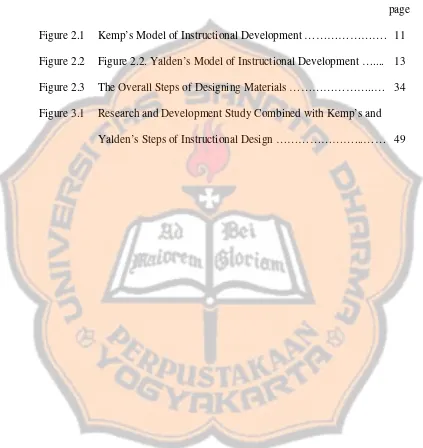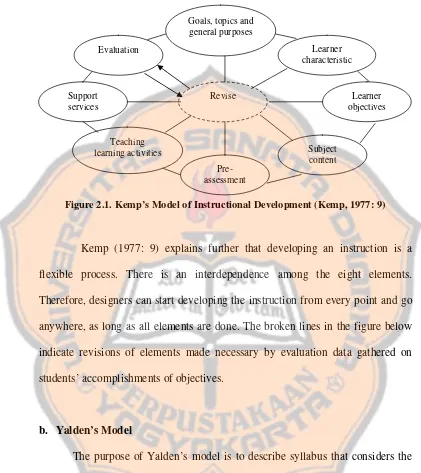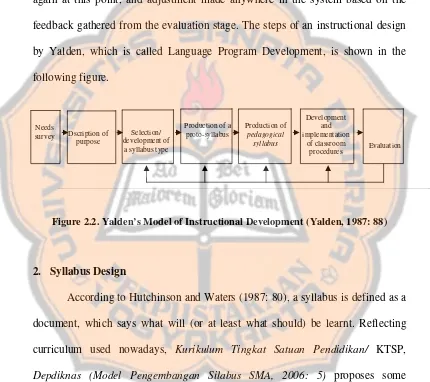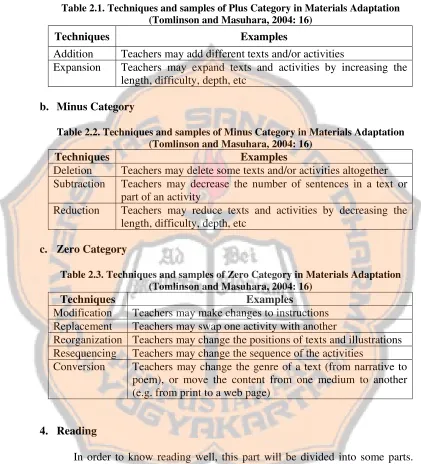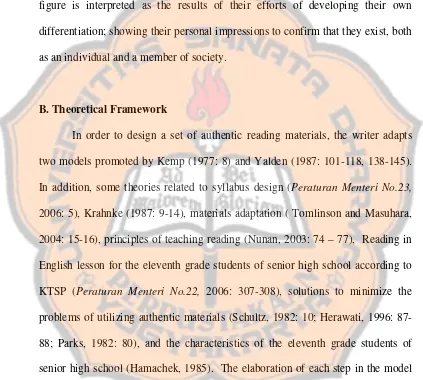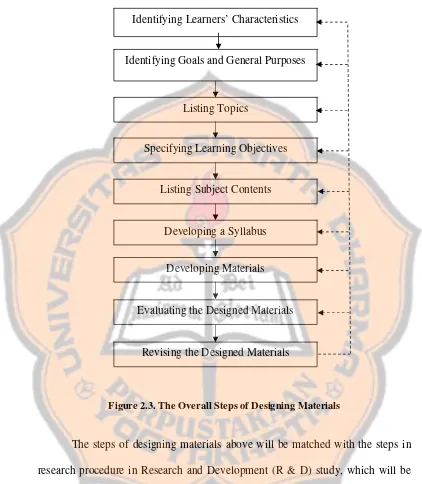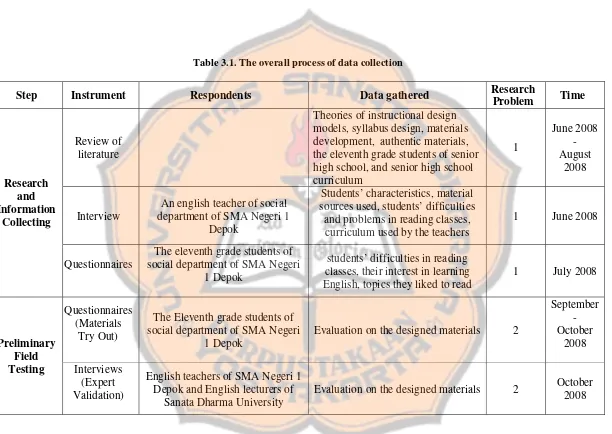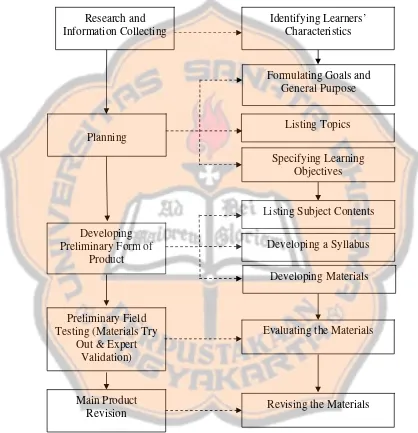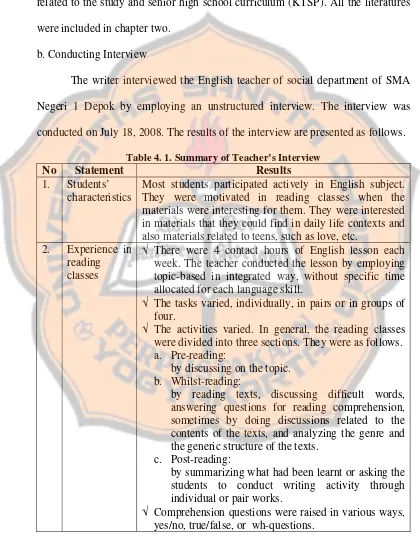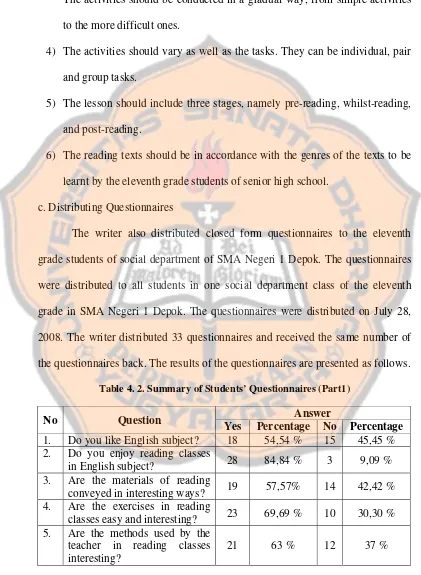i
DESIGNING A SET OF AUTHENTIC READING MATERIALS FOR THE ELEVENTH GRADE STUDENTS
OF SMA NEGERI 1 DEPOK
A Thesis
Presented as Partial Fulfillment of the Requirements to Obtain the Sarjana Pendidikan Degree
in English Language Education
By Elisabeth Aditya Student Number: 041214034
ENGLISH LANGUAGE EDUCATION STUDY PROGRAM DEPARTMENT OF LANGUAGE AND ARTS EDUCATION FACULTY OF TEACHERS TRAINING AND EDUCATION
SANATA DHARMA UNIVERSITY YOGYAKARTA
v
DEDICATION PAGE
"The Im po ssib le Dre a m " To dream the impossible dream To fight the unbeatable foe To bear with unbearable sorrow To run where the brave dare not go
To right the unrightable wrong To love pure and chaste from afar To try when your arms are too weary To reach the unreachable star
This is my quest To follow that star No matter how hopeless No matter how far
To fight for the right Without question or pause To be willing to march into Hell For a heavenly cause
And I know if I'll only be true To this glorious quest
That my heart will lie peaceful and calm When I'm laid to my rest
And the world will be better for this
That one man, scorned and covered with scars Still strove with his last ounce of courage To reach the unreachable star
This thesis is dedicated to
♥
My beloved mother and father
♥
Mas Andi
♥
Mbak Lia
vi
ACKNOWLEDGEMENTS
I would like to dedicate my first gratitude to my Lord, Jesus Christ for His blessings, guidance, mercy, helps, and friendships so that I was able to finish my thesis. He always makes everything right and possible when I feel everything going wrong and distressed.
I would like to address my sincere gratitude to my sponsor, Dr. Retno Muljani, M.Pd. for her willingness to share her knowledge and expertise. She has been great in her invaluable supports, criticism, guidance, and suggestions to my thesis. I also would like to express my sincere appreciation to Laurentia Sumarni, S.Pd and Caecilia Tutyandari, S.Pd., M.Pd. for willingly spending their time evaluating my designed materials.
I warmly thank the English teachers of SMA Negeri 1 Depok, Sri Suryanti, S.Pd. and Subiyadi, S.Pd. I thank them for helping and guiding me as well as giving precious suggestions for my designed materials.
I am deeply grateful to all lecturers of English Language Education Study Program of Sanata Dharma University for their guidance, dedication, and knowledge they have shared during my study in this university. I also thank PBI secretariat staff, Mbak Danik and Mbak Tari for their countless services and help during my study.
vii
Andi, mbak Lia, and mas Tinus for their love, patience, advice, help and support in accomplishing my thesis. They always brighten my days.
I am very grateful to the following people for their help in accomplishing my thesis: Agustina Budi Pratiwi, Theresia Vina Indriyani, and Agnes Nora E.W. I am also happy to have an opportunity to give my appreciation to Rini and
Kristin. I thank them for their willingness to be the proofreaders for my thesis. Besides, I wish to thank all of PBI students 2004, GARUDA English Course (Retno, Maya, Dian, Joni, Oki, and Mbak Putri) for willingly sharing the joy and spirit during my study in this university and my friends (Shanty, Ike, Dixna, Lisa, Miss, Sabrin, Desi, and Sari) for their friendship, support, and the help. In addition, I warmly thank all teachers of REALIA English Course and
Global Lingua who have helped me learn how to be a good teacher.
Finally, I would like to show my gratitude to all those who have helped and supported me and could not be mentioned by names. This thesis might not have been finished without them.
viii
TABLE OF CONTENTS
Page
PAGE OF TITLE ... i
PAGES OF APPROVAL ……… ii
STATEMENT OF WORK’S ORIGINALITY ………. iv
DEDICATION PAGE ………. v
ACKNOWLEDGEMENTS ……… vi
TABLE OF CONTENTS ……… viii
LIST OF TABLES ……….. xii
LIST OF FIGURES ……… xiii
LIST OF ABBREVIATIONS ……… xiv
LIST OF APPENDICES ……… xv
ABSTRACT ………. xvi
ABSTRAK ………. xvii
CHAPTER 1: INTRODUCTION A. Research Background ………. 1
B. Problem Formulation ……….. 4
C. Problem Limitation .……… 4
D. Research Objectives ………... 5
E. Research Benefits ……….. 5
ix
CHAPTER II: THEORETICAL REVIEW
A. Theoretical Description ………... 8
1. Instructional Design Models ………... 8
a. Kemp’s Model ……….. 9
b. Yalden’s Model ……… 11
2. Syllabus Design ……….. 13
3. Materials Development ………... 15
4. Reading ……… 17
a. Background of Reading ………... 18
b. Reading Processes ………. 18
c. Principles for Teaching Reading……… 19
d. Reading in English Lesson for the Eleventh Grade Students of Senior High School according to KTSP ………...………. 22
5. Authentic Materials a. Definition of Authentic Materials ………... 23
b. Advantages of Authentic Materials ………. 24
c. Problems with Authentic Materials ………. 26
d. Solutions to Minimize the Problems of Utilizing Authentic Materials ………..………... 26
6. The Eleventh Grade Students of Senior High School ………... 28
x
CHAPTER III: METHODOLOGY
A. Research Method ………... 35
1. Research and Information Collecting ……… 36
2. Planning ………. 36
3. Developing a Preliminary Form of Product ……….. 37
4. Preliminary Field Testing ……….. 37
5. Main Product Revision ……….. 38
B. Research Participants ………. 39
C. Research Setting ………... 41
D. Research Instruments ………. 41
1. Interview ………..……….. 41
2. Questionnaires ……… 42
E. Data Collection ……….………. 43
F. Data Analysis Techniques.……….. 47
G. Research Procedures ………... 48
CHAPTER IV: RESEARCH RESULTS AND DISCUSSION A. The Steps of Designing a Set of Authentic Reading Materials for the Eleventh Grade Students of SMA Negeri 1 Depok ..……..… 50
1. Conducting Research and Information Collecting……… 50
a. Review of Relevant Literature….……… 51
b. Conducting Interview..…….………... 51
xi
2. Planning ……..………. 55
a. Formulating the Goals and General Purpose……….. 55
b. Listing the Topics ……….. 56
c. Specifying Learning Objectives ………. 57
3. Developing the Preliminary Form of Product ………. 58
a. Listing the Subject Contents ……..……… 58
d. Designing a Syllabus …………...……….. 59
c. Developing Materials ……… 63
4. Preliminary Field Testing ……….………... 63
a. Expert Validation .……….. 64
b. Materials Try Out……… ……….. 69
5. Main Product Revision ……….… 71
B. The Presentation of the Designed Materials ……… 73
CHAPTER V: CONCLUSIONS AND SUGGESTIONS A. Conclusions ……… 77
B. Suggestions ……… 79
REFERENCES ……….……… 81
xii
LIST OF TABLES
Table Page
Table 2.1: Techniques and Samples of Plus Category in Materials Adaptation.. Table 2.2: Techniques and Samples of Minus Category in Materials Adaptation.... Table 2.3: Techniques and Samples of Zero Category in Materials Adaptation. Table 3.1: The Overall Process of Data Collection………... Table 4.1: Summary of Teacher’s Interview………... Table 4.2: Summary of Students’ Questionnaires (Part1)………... Table 4.3: Summary of Students’ Questionnaires (Part 2)……….. Table 4.4: The Lists of Topics………. Table 4.5: The Specific Learning Objectives of the Designed Materials…….... Table 4.6: The Results of Interviews of Expert Validation……….… Table 4.7: The Results of Questionnaires in Materials Try Out…………..…... Table 4.8: The Presentation of the Designed Materials………...
xiii
LIST OF FIGURES
page
Figure 2.1 Kemp’s Model of Instructional Development ………. 11 Figure 2.2 Figure 2.2. Yalden’s Model of Instructional Development ….... 13 Figure 2.3 The Overall Steps of Designing Materials ………..… 34 Figure 3.1 Research and Development Study Combined with Kemp’s and
xiv
LIST OF ABBREVIATIONS
No. Abbreviations Stand for
KTSP BC
CS R & D
Kurikulum Tingkat Satuan Pendidikan Basic Competence
xv
LIST OF APPENDICES
Page
Appendix A Letters of Permission………..…….….... 83
Appendix B Interview Guideline for Research and Information Collecting.... 85
Appendix C Questionnaire for Research and Information Collecting……..… 86
Appendix D Interview Guideline for Expert Validation….………... 88
Appendix E Questionnaire for Materials Try Out 1……….….... 89
Appendix F Questionnaire for Materials Try Out 2……….….... 90
Appendix G Materials Overview………...………..…….….... 91
Appendix H Syllabus and Lesson Plans………....… 93
xvi
ABSTRACT
Aditya, Elisabeth. 2009. Designing a Set of Authentic Reading Materials for the Eleventh Grade Students of SMA Negeri 1 Depok. Yogyakarta: English Language Education Study Program, Sanata Dharma University.
Reading is one of the most important language skills in language acquisition. However, the former observations conducted by the writer showed that there was a problem where sometimes reading classes made students bored and sleepy. In order to provide interesting and relevant materials, the writer proposes the use of authentic materials. It was based on the consideration that the sources of authentic materials vary, so that we can choose materials that are interesting for the students. In addition, authentic materials expose the students to the language in the real situation, so the materials can help the students to achieve informational literacy level, as senior high school students are required to achieve it. Considering that, this study was aimed at developing a set of authentic reading materials for the eleventh grade students of SMA Negeri 1 Depok.
There were two questions formulated in the problem formulation i. e. (1) how is a set of authentic reading materials for the eleventh grade students of SMA Negeri 1 Depok designed? and (2) what does the designed set of the materials look like?. To address the first question, the writer employed the adaptation of Kemp’s and Yalden’s instructional design models combined with the Research and Development (R & D) steps. There were eight instructional design steps employed in this study, namely, (1) identifying learners’ characteristics, (2) formulating goals and general purpose, (3) listing topics, (4) specifying learning objectives, (5) listing subject contents, (6) developing a syllabus, (7) developing materials, (8) evaluating the designed materials, and (9) revising the designed materials.
In this study, the data obtained through the research and information collecting step were served as the basis to develop the materials. After designing the materials, the writer conducted expert validation to gain evaluation on the designed materials from some English teachers of SMA Negeri 1 Depok and some English lecturers of Sanata Dharma University. Besides, the designed materials were tried out to students of one social class of the eleventh grade of SMA Negeri 1 Depok and were evaluated by the students. The data from the expert validation and the materials try out were analyzed using percentages and qualitative data analysis. The evaluation was then employed as the basis for revisions. The revisions included the topics, the subject contents, and the designed materials.
xvii
ABSTRAK
Aditya, Elisabeth. 2009. Designing a Set of Authentic Reading Materials for the Eleventh Grade Students of SMA Negeri 1 Depok. Yogyakarta: Program Studi Pendidikan Bahasa Inggris, Universitas Sanata Dharma.
Reading merupakan salah satu dari kemampuan berbahasa yang paling penting dalam pemerolehan keterampilan (acquisition) berbahasa. Namun, observasi yang telah dilakukan oleh penulis menunjukkan bahwa terdapat sebuah masalah, dimana terkadang kelas reading membuat para siswa bosan dan mengantuk. Untuk menyediakan materi yang menarik dan relevan, penulis mengusulkan penggunaan materi autentik. Hal ini didasarkan pada pertimbangan bahwa sumbernya sangat beragam, sehingga kita dapat memilih materi yang menarik bagi para siswa. Selain itu, materi autentik menunjukkan bahasa sehari-hari kepada para siswa, sehingga diharapkan dapat membantu para siswa mencapai tingkat informational.. Berdasarkan kedua alasan tersebut, penelitian ini bertujuan untuk mengembangkan seperangkat materi reading yang autentik bagi siswa kelas XI SMA Negeri 1 Depok.
Dalam penelitian ini, terdapat dua pertanyaan dalam perumusan masalah yaitu (1) bagaimanakah seperangkat materi reading autentik untuk siswa kelas XI SMA Negeri 1 Depok dirancang? dan (2) bagaimanakah penyajian materi reading yang telah disusun tersebut?. Untuk menjawab pertanyaan pertama, penulis mengadaptasi model perancangan instruksional yang dikembangkan oleh Kemp dan Yalden yang dikombinasikan dengan langkah-langkah Research and Development (R & D). Terdapat delapan langkah perancangan instruksional dalam penelitian ini, yakni (1) pengidentifikasian karakteristik siswa, (2) perumusan sasaran dan tujuan besar, (3) perumusan topik, (4) perincian tujuan pembelajaran, (5) perincian isi materi, (6) penyusunan silabus, (7) pengembangan materi, (8) pengevaluasian materi, dan (9) perevisian materi.
Dalam penelitian ini, data yang diperoleh melalui penelitian dan pengumpulan informasi digunakan sebagai dasar pengembangan materi. Setelah selesai merancang materi, penulis mengadakan expert validation untuk mendapatkan evaluasi dari para guru Bahasa Inggris SMA Negeri 1 Depok dan dosen Bahasa Inggris Universitas Sanata Dharma. Selain itu, materi yang telah selesai dirancang diujikan pada para siswa kelas XI SMA Negeri 1 Depok dan dievaluasi oleh mereka. Data yang diperoleh dari expert validation dan pengujian materi kemudian dianalisis menggunakan prosentase dan analisa data kualitatif. Evaluasi kemudian digunakan sebagai acuan untuk perevisian materi. Perevisian meliputi topik, isi materi, dan materi.
xviii
1
CHAPTER I
INTRODUCTION
This chapter discusses the research background, problem formulation, problem limitation, research objectives, research benefits, and the clarification of terms.
A. Research Background
Nowadays, the curriculum which is used in Indonesia is Kurikulum Tingkat Satuan Pendidikan/ KTSP. In this curriculum, every school is given an opportunity to develop and manage the curriculum based on its condition and aspiration (Muslich, 2007: 10). The curriculum (Peraturan Menteri No. 22, 2006: 307) states that there are four skills which need to be learnt in English lessons and one of those skills is reading.
Reading, as described by Bamberger (1975: 7-8), is an important aspect for individuals and for society. Reading serves many different purposes. Through reading, people can learn ideas, concepts, and attitudes. By reading people can take much information they need in their daily life.
Therefore, reading practices in senior high school is needed. Furthermore, KTSP (Peraturan Menteri No.22, 2006: 307) states that senior high school students are expected to achieve informational literacy level, meaning that they are expected to be able to access knowledge using linguistic ability. In this case, reading is very important to enable the students to access knowledge in their daily life contexts.
However, some former observations in senior high schools in Jogjakarta conducted by the writer showed that reading sometimes made students feel bored and sleepy. In addition, the writer has also interviewed a teacher of SMA Negeri 1 Depok, Yogyakarta about the situation of reading classes in English lesson in that school. The results of the interview show that reading classes often make the students bored.
In that situation, teachers should be active in finding interesting materials for the students to make them motivated. This idea is supported by the teacher of SMA Negeri 1 Depok who stated that there is a need for interesting materials to make them motivated in reading classes. This idea is also supported by syllabus development principles in KTSP. One of the principles is the identification of materials. Muslich (2007: 29) says that this principle requires teachers to select and develop materials that are relevant to the students’ needs and the society’s demands.
language community”. They are usually not produced for language teaching. They are mostly produced and consumed by the target language speaking group. There are three main reasons for proposing authentic materials in reading classes.
One of the main ideas of using authentic materials in the classroom is to make the lesson interesting. Milne, as stated by Herawati (1996: 83) states that authentic materials from magazines and newspapers, offer two advantages: “a wide variety of interesting articles is readily available and the materials can be constantly updated so that topical subjects can be covered that hold the students’ attention.”
Besides, using authentic materials can enhance the students’ motivation to read, as the students will get satisfaction after being able to read authentic texts. Howell (1986: 40) states that “the authenticity of the texts provides for motivated reading, leaving the foreign students with a sense of pride at having accomplished a recognizable feat in the challenging arena of English-language learning.”
It is pointed out that authentic materials can give some benefits for the students. Therefore, the writer proposes to design reading materials for the eleventh grade students of SMA Negeri 1 Depok by utilizing authentic materials which are in accordance with the students’ needs and interests.
B.Problem Formulation
Based on the research background, the writer formulates the following research problems:
1. How is a set of authentic reading materials for the eleventh grade students of SMA Negeri 1 Depok designed?
2. What does the designed set of authentic reading materials for the eleventh grade students of SMA Negeri 1 Depok look like?
C.Problem Limitation
D. Research Objectives
There were two objectives in this study. They are described below.
1. To discover how a set of authentic reading materials for the eleventh grade students of SMA Negeri 1 Depok is designed.
2. To present the designed set authentic reading materials for the eleventh grade students of SMA Negeri 1 Depok.
E. Research Benefits
This research is intended to give benefits for: 1. English Teachers
English teachers of senior high school can use the designed reading materials as alternative materials in teaching their students. By doing so, they can teach their students by using materials that are relevant and more interesting to learn. When it happens, the teachers will find it easier to raise their students’ motivation to learn.
2. Students
The authentic reading materials would help the students to develop their reading skills. Moreover, the authentic materials that are used will enable them to experience language in the real life context. By doing so, the students will find it easier to read other authentic texts written in English in their daily life.
3. Other Writers
students. By doing so, they will be able to design authentic reading materials which are suitable for the level of students for whom the materials are intended to.
F. Clarification of Terms
The writer would like to define some important terms related to the topic discussed in this study.
1. Reading
According to Nunan (2003: 68) reading is “a fluent process of readers combining information from a text and their own background knowledge”. It means that the goal of reading is the comprehension of the texts read by the reader which needs not only the knowing of the words in the passage, but also their background knowledge related to the topic of the text read.
In this study, reading is meant to be the process of comprehending texts by digging the readers’ background knowledge.
2. Authentic Materials
Berardo (2006: 2-3) says that authentic materials are “materials that have been produced to fulfill some social purposes in the language community”. They are usually not produced for language teaching. They are mostly produced and consumed by the target language speaking group.
rather than being specially created for the purposes of language learning and teaching.
In this study, authentic materials refer to materials that are produced to fulfill some social purposes that are consumed by target language community. The materials used in this study will be taken from magazines, newspapers, and some other sources providing authentic materials.
3. The Eleventh Grade Students of Senior High School
Rumjati (2006: 8) describes senior high school, generally called SMA (Sekolah Menengah Atas), as one of education levels in Indonesia. This level is considered as the preparation level before students continue their study to a university. The students at this level of education are expected to have some competencies of life skills.
8
CHAPTER II
THEORETICAL REVIEW
This chapter discusses theories underlying this study. There are two main parts in this chapter. The first part deals with theoretical description, while the second part deals with theoretical framework employed in designing authentic reading materials for the eleventh grade students of SMA Negeri 1 Depok.
A. Theoretical Description
This part explains theories related to this study. Since the purpose of this study is designing materials, this part begins with theory of instructional design, then theory of materials development. Subsequently, the writer elaborates some theories of reading and authentic materials since the materials designed in this study are reading materials which utilize authentic texts. The last theory explains the eleventh grade students of senior high school since the designed materials are intended for them.
1. Instructional Design Models
activities and resources, and evaluation (1977: 8-9). While Yalden’s model completes Kemp’s model by emphasizing on syllabus design.
a. Kemp’s Model
According to Kemp (1977: 8), it is important to make an instructional design plan because it will help the designers to get familiar with the design which will be developed later. The followings are some stages designed by Kemp: a. Determining goals, topics and general purposes
The selection of topics should consider the items from the simple to complex level, the correlation with subject content, and students’ characteristics. The general purposes are derived from the topics. They explicitly express students’ and teacher’s accomplishments.
b. Mentioning Learners’ Characteristics
The designer identifies the characteristics of students, including their capabilities, needs and interests. This information should affect the instructional planning, including the determination of topics, the levels at which topics are introduced, the choice of sequencing objectives, the depth of treatments and the variety of learning activities.
c. Specifying learning objectives
The designer determines learning objectives or certain performances that are measurable to be achieved by students.
d. Listing subject content
taught or learned in this topic? What facts, concepts, and principles related to this topic? What steps are involved in necessary procedures related to this topic? What techniques are required in performing essential skills?
e. Developing pre-assessment
The designer develops pre-assessment to determine students’ background knowledge about the topic. In order to plan learning activities, designers should find out specifically the following: to what extent each student has acquired the necessary prerequisites for studying the topic and what the student may have already mastered about the subject to be studied.
f. Selecting teaching learning activities and resources
The designer selects teaching learning methods and instructional resources that will be most appropriate for accomplishing each objective through subject content. The designer needs to know the strengths and weaknesses of alternative methods and of various materials. He/she can make his/her selection in terms of students’ characteristics and needs.
g. Coordinating support services
The designer coordinates the support services required to implement the design plan. They are budget, facilities, equipment, and schedules.
h. Evaluating students’ learning
Figure 2.1. Kemp’s Model of Instructional Development (Kemp, 1977: 9)
Kemp (1977: 9) explains further that developing an instruction is a flexible process. There is an interdependence among the eight elements. Therefore, designers can start developing the instruction from every point and go anywhere, as long as all elements are done. The broken lines in the figure below indicate revisions of elements made necessary by evaluation data gathered on students’ accomplishments of objectives.
b. Yalden’s Model
The purpose of Yalden’s model is to describe syllabus that considers the communicative needs of students. A communicative syllabus itself is a syllabus which is designed for describing a classroom experience which is more appropriate in an environment of real language and art (Yalden, 1987: 85). According to Yalden (1987: 101-118, 138-145), there are eight steps in designing instructions. Those steps are presented on the following page.
Goals, topics and general purposes
Learner characteristic
Learner objectives
Subject content Pre-
assessment Teaching
learning activities Support
services
Evaluation
1) Conducting a need survey
This step is conducted to find learners’ needs and to write objectives that are appropriate for the learners.
2) Stating description of the purpose
Having conducted a need survey, the designer will have a description of the purpose of the program.
3) Selecting a syllabus to be carried out in the program
The choice of syllabus type is done when the general category of a language program has been decided.
4) Production of proto-syllabus
The designer selects and combines syllabus contents which are in line with the syllabus type.
5) Production of pedagogical syllabus
The specification of every single word and phrase will be conducted in this step.
6) Development and implementation of classroom procedures
Communicative syllabus will put teacher’s role as a facilitator. Therefore, classroom activities conducted are based on the learners’ activity.
7) Evaluation
8) Recycling stage
The last step is intended to fit between goals set and the final performance of the learners. If there are discrepancies, materials and teaching approaches are revised. This is labeled “recycling stage” because the whole cycle can be begun again at this point, and adjustment made anywhere in the system based on the feedback gathered from the evaluation stage. The steps of an instructional design by Yalden, which is called Language Program Development, is shown in the following figure.
Figure 2.2. Yalden’s Model of Instructional Development (Yalden, 1987: 88)
2. Syllabus Design
According to Hutchinson and Waters (1987: 80), a syllabus is defined as a document, which says what will (or at least what should) be learnt. Reflecting curriculum used nowadays, Kurikulum Tingkat Satuan Pendidikan/ KTSP, Depdiknas (Model Pengembangan Silabus SMA, 2006: 5) proposes some components which should be included in a syllabus. The components are:
a. Identification includes the name of the school, subject, and class/grade as well as semester
Needs
survey Dscription of purpose
Selection/ development of
a syllabus type
Production of a proto-syllabus
Production of pedagogical syllabus
Development and implementation
of classroom
b. Standard competences which are basic abilities/skills which the students should have in a learning process
c. Basic competences are the statements of the expected performances after the students experience the learning process in certain competence
d. Indicators are specific form of basic competence which are measurable
e. The main materials are a description or outline of a set of materials presented in the students’ learning experience
f. Learning experience which students will undergo, including arrangement of activities which students should do to achieve the basic competences
g. Time allocation providing organization of time which depends on the time provided for conducting the whole learning process
h. Assessment to assess students’ achievements
i. Sources, which may include books, brochures, magazines, and newspapers. According to Krahnke (1987: 9-14), there are six types of syllabus, but almost all actual language teaching syllabi are the combinations of two or more of the types defined here. Those types of syllabus are:
a a structural syllabus, in which content of language teaching is a collection of forms and structures, usually grammatical, of language being taught.
c a situational syllabus, in which content of language teaching is a collection of real or imaginary situations in which language occurs or is used.
d a skill-based syllabus, in which content of language teaching is a collection of specific abilities that may play a part in using language. Primary purpose of skill- based instruction is to learn specific language skill.
e a task-based syllabus, in which content of teaching is a series of complex and purposeful tasks that students want or need to perform with language learnt. f a content-based syllabus, in which primary purpose of instruction is to teach
some contents or information using language that students are also learning. Subject matter is primary and language learning occurs incidentally to content learning.
3. Materials Development
Materials are developed in order to present models of correct language used in a target situation (Hutchinson and Waters, 1987: 106). Hutchinson and Waters (1987: 108-109) describe a model that should be taken into consideration in developing materials. The model consists of four elements: input, content focus, language focus, and task.
a. Input
communication, and opportunities for learners to use their information processing skills and their existing knowledge both of the language and the subject matter.
b. Content focus
Content of language means the information and feelings conveyed by the language which is learned. The content should be exploited to generate meaningful communication in the classroom.
c. Language focus
Good materials should involve opportunities for both analysis and synthesis. Language focus enables learners to have chances to take the language to pieces, study how it works, and practice it.
d. Tasks
After designing materials, the designer should plan communicative tasks so that learners can use the content and language knowledge they have built up through the unit.
However, in developing materials, teachers usually do what is called materials adaptation. According to Tomlinson and Masuhara (2004: 11), materials adaptation means changing existing materials so that they become more suitable for specific learners, teachers, or situation.
a. Plus Category
Table 2.1. Techniques and samples of Plus Category in Materials Adaptation (Tomlinson and Masuhara, 2004: 16)
Techniques Examples
Addition Teachers may add different texts and/or activities
Expansion Teachers may expand texts and activities by increasing the length, difficulty, depth, etc
b. Minus Category
Table 2.2. Techniques and samples of Minus Category in Materials Adaptation (Tomlinson and Masuhara, 2004: 16)
Techniques Examples
Deletion Teachers may delete some texts and/or activities altogether Subtraction Teachers may decrease the number of sentences in a text or
part of an activity
Reduction Teachers may reduce texts and activities by decreasing the length, difficulty, depth, etc
c. Zero Category
Table 2.3. Techniques and samples of Zero Category in Materials Adaptation (Tomlinson and Masuhara, 2004: 16)
Techniques Examples
Modification Teachers may make changes to instructions Replacement Teachers may swap one activity with another
Reorganization Teachers may change the positions of texts and illustrations Resequencing Teachers may change the sequence of the activities
Conversion Teachers may change the genre of a text (from narrative to poem), or move the content from one medium to another (e.g. from print to a web page)
4. Reading
a. Background of Teaching Reading
The background of teaching reading according to Nunan will be presented here.
“In Western cultures, oral reading was the primary practice until the nineteenth century. In about 1880 a debate began on the advantages of silent reading versus oral reading” (Nunan, 2003:69).
Nunan (2003: 69) explains further that classroom approaches to teaching reading should emphasize silent reading when the goal of reading is comprehension of text.
b. Reading Processes
Understanding the process of reading means understanding models of how words are recognized and how long they are kept in working memory (Nunan, 2003: 70). The models of reading process can be divided into three categories (Nunan, 2003: 70-73). Those categories are:
1) Bottom-up model
taking in letters, combining these to form words, then combining the words to form phrases, clauses and sentences of text.
2) Top-down model
In top-down model, readers draw upon their knowledge of the world and the structure of the sentences to analyze text. In this model, the readers are seen as bringing hypotheses to bear on the text, and using text data to confirm or deny the hypotheses. The hypotheses may relate to the whole text and be generated by reference to supposed schemata. In this model, the readers come to the text with previously formed plan or background knowledge. The readers read the text by reading the sentences and try to find the information using their background knowledge.
3) Interactive model
Interactive model of reading combines elements of both bottom-up and top-down models, assuming that a pattern is synthesized based on information provided simultaneously from several knowledge sources. While reading, readers can apply bottom-up process by recognizing the new vocabulary and the new pattern they have not got before. By doing this, readers are expected to be able to get information from text. Meanwhile, readers also apply top-down process by predicting what the content of the text is about and the continuation of the text.
c. Principles for Teaching Reading
1) Exploit readers’ background knowledge
Background knowledge involves reader’s experience like life experiences, knowledge of how texts can be organized rhetorically; knowledge of how one’s first language works, knowledge of how the second language works, and cultural background and knowledge. Those experiences are brought into the texts. According to Nunan (2003: 74) “Reading can be significantly enhanced if background knowledge can be activated by setting goals, asking questions, making predictions, teaching text structure, and so on”.
2) Build a strong vocabulary base
Nunan (2003: 74) says that basic vocabulary should be explicitly thought and L2 readers should be taught to use context to effectively guess the meanings of less frequent vocabulary.
3) Teach for comprehension
Monitoring comprehension is a very important part to gain successful reading. It includes verifying that the predictions being made are correct and checking that the readers do make an important adjustment when meaning is not accomplished.
4) Work on increasing reading rate
Teachers of English language should improve their students’ reading rate and develop reading comprehension skills simultaneously. They should be in a balanced condition. One important thing to be done is decreasing the dependency toward looking at dictionary by emphasizing some skills like scanning, skimming, predicting, and identifying the text.
5) Teaching reading strategy
Based on Oxford (1996) as stated by Nunan (2003: 76), a strategy is “the tools for active, self-directed involvement that is necessary for developing communicative ability”. Nunan adds that “a good technique to sensitive students to that strategies they use is to get them verbalize (or to talk about) their thought processes as they read.”
6) Encourage readers to transform strategies into skills
As learners consciously learn and practice specific reading strategies, the strategies move from conscious to unconscious: from strategy to skill (Nunan, 2003: 77).
7) Build assessment and evaluation into your teaching
8) Strive for continuous improvement as a reading teacher
The quality of the individual teacher is integral to success of second/foreign language readers (Nunan 2003: 77)
d. Reading in English Lesson for the Eleventh Grade Students of Senior
High School according to KTSP
The principles of teaching reading in English lesson of senior high school students according to KTSP are important in this study since the writer designs reading materials for the eleventh grade students of SMA Negeri 1 Depok based on the curriculum used nowadays, KTSP.
The level of English accomplishments of senior high school students should achieve three levels, namely performative, functional, and informational. In performative level, students are expected to be able to read using the symbols that are used in reading passage. In functional level, students are expected to be able to use the language to fulfill their daily needs, such as to read newspapers, magazines, or directions, while in informational level, students are expected to be able to access knowledge using linguistic ability(Peraturan Menteri No.22, 2006: 307).
1. the ability to understand written texts to achieve informational level. 2. the ability to understand various short functional texts and monologues in
the form of procedure, descriptive, recount, narrative, report, news item, analytical exposition, hortatory exposition, and spoof.
3. Supporting competencies, including linguistic competence, (the use of grammar and vocabulary, intonation, and tones), socio-cultural competence (the use of appropriate expressions in various contexts), and strategy competence (solving problems rising when reading texts).
5. Authentic Materials
Theoretical description of authentic materials is divided into some parts. They include the definitions of authentic materials, advantages of authentic materials, problems with authentic materials, and solutions to minimize the problems of utilizing authentic materials.
a. Definitions of Authentic Materials
needs of individual teachers and learners. It means that we need materials which are not textbooks. These kinds of materials are usually called authentic materials.
There are some definitions of authentic materials. First, Abbot and Wingard (1987: 279) define authentic materials as “materials which are actually used in a mother-tongue situation.” However, they also mention that a teacher or a course writer may also produce authentic materials if he makes up an advertisement or other forms of authentic texts which are much like the real thing. It means that they make the concept of authentic materials not limited only to any texts which are specially designed by teachers for language learning purposes.
Nonetheless, Nunan (2003: 329) has a different opinion from Abbot and Wingard’s concept of authentic. He states that authentic texts should be authentic. The texts should be taken from real situations and usage, and should not be written especially for language learning purposes.
In this study, authentic materials refer to materials which are designed for native speakers, not for language students. They are not originally written for language teaching purposes, but for fulfilling social purposes.
b. Advantages of Authentic Materials
new information for them. Parks (1982: 40) states that newspapers as a form of authentic materials contain information which is new to students and even would be on the subject of their personal interests. Melvin and Stout (1987: 51) add that the use of authentic materials can give learners information and knowledge about what happens on the other side of the world.
Another advantage of authentic materials is that they bring positive effect to learners’ motivation. This is because the topics are interesting and up-to-date. Beside that, the learners will get satisfaction after being able to read authentic texts. Howell (1986: 40) states that “the authenticity of the texts provides for motivated reading, leaving the foreign students with a sense of pride at having accomplished a recognizable feat in the challenging arena of English-language learning.”
In addition, authentic materials provide learners with information on the cultural and social life of foreign countries. In other words, learners will not only be able to learn the target language, but also the target society and its culture as well. Parks (1982: 40) mentions that by using newspapers, as one example of authentic materials, students will not only learn to read newspaper articles as well as to learn the language, but also the culture that the articles reflect.
c. Problems with Authentic Materials
It is pointed out that alongside with the advantages of authentic materials, there might be some problems in utilizing authentic materials. The problems when using authentic materials are as follows.
The first problem is related to the language used in the authentic materials. Berardo (2006: 65) states that language used is sometimes too difficult and complicated and that foreign learners will experience serious problems in comprehending the readings.
The second problem is that an influence of the culture and social context of where authentic materials are made sometimes makes foreign learners confused in comprehending the texts. This idea is supported by Berardo (2006: 65) who states that authentic materials may be too culturally biased and there are too many structures which are mixed, causing lower levels have a hard time decoding the texts.
In addition, according to Berardo, authentic texts which consist a great deal of cultural information will make students confused. It is because the students find attitudes and behaviours which are inappropriate with their own culture.
d. Solutions to minimize the Problems of Utilizing Authentic Materials
Teachers can solve the problems of too-difficult language used in authentic materials by careful selection of texts. In selecting appropriate reading texts for a group of EFL learners, teachers should select texts with an appropriate level of difficulty for the learners. Schultz (1982: 10) points out that suitable texts will avoid ‘frustrating reading.’
Furthermore, in dealing with cultural problems in authentic materials, teachers should be able to bridge cultural gap by presenting cultural information to students. This idea is supported by Steffenson and Joag-Dev as stated by Herawati (1996:87) who state that “learning to read is easier when the cultural background is familiar and students can draw on cultural information in the decoding process.”
6. The Eleventh Grade Students of Senior High School
In general, the eleventh grade students of senior high school are 17 years old. According to Hamachek (1985) in his book entitled Psychology in Teaching, Learning and Growth, at this age, teenagers start looking for their own personality; they concern about appearance and start considering the importance of relationship with others. They make their own decision, develop moral values, establish sexuality awareness and closer relationship with others, and hunt for challenging moments in their life.
Further, according to Hamachek (1985), there are three social cognitive problems in the cognitive development of the eleventh grade students of senior high school. The problems are related to how they form and arrange their own point of view and decision about other features based on several considerations, how they try to value and react towards others as they value and react towards themselves, and how they form their self consciousness, figuring out their personal characteristics by creating social interaction and conceptualizing social norms and rules around them.
In relation to reading passages that are interesting for senior high school students, Oka conducted research on reading interests of senior high school students in Indonesia. The results of his research showed the kinds of reading passage that senior high school students prefer to read., as described by Oka (1982: 4-5) describes the kinds of reading passage. The kinds of reading passages are described on the following pages.
a. Readings on general knowledge
Readings on general knowledge consist of articles informing something to add knowledge related to daily life needs, e.g. small worms that are dangerous, glasses for dogs, sun movements, etc.
b. Readings on socio-cultural phenomenon
Readings on socio-cultural phenomenon include articles containing factual news related to society and the cultures, e.g. forest tourism in Bali, hedonism in youth, preservation of water source, etc.
c. Readings on famous figures
Readings on famous figures include articles on people who struggle for maintaining their life and/or reaching their dreams or who have interesting personality, e.g. Dr. Johnson, a bellboy who succeeded to become a surgeon. d. Literatures
Readings on literature only cover short stories. e. Readings on ethic and government
f. Others, including crossword puzzle, anecdotes, advertisements, etc.
Senior high school students’ reading interest is mostly in readings on general knowledge. They tend to search for new knowledge and new experience, while their big interest in readings on socio-cultural phenomenon and readings on figure is interpreted as the results of their efforts of developing their own differentiation; showing their personal impressions to confirm that they exist, both as an individual and a member of society.
B. Theoretical Framework
In order to design a set of authentic reading materials, the writer adapts two models promoted by Kemp (1977: 8) and Yalden (1987: 101-118, 138-145). In addition, some theories related to syllabus design (Peraturan Menteri No.23, 2006: 5), Krahnke (1987: 9-14), materials adaptation ( Tomlinson and Masuhara, 2004: 15-16), principles of teaching reading (Nunan, 2003: 74 – 77), Reading in English lesson for the eleventh grade students of senior high school according to KTSP (Peraturan Menteri No.22, 2006: 307-308), solutions to minimize the problems of utilizing authentic materials (Schultz, 1982: 10; Herawati, 1996: 87-88; Parks, 1982: 80), and the characteristics of the eleventh grade students of senior high school (Hamachek, 1985). The elaboration of each step in the model of designing the materials is presented on the following pages.
Step 1: identifying learners’ characteristics
to the eleventh grade students of senior high school. These analyses are aimed at discovering learners’ needs and teachers’ expectations toward the designed materials.
Step 2: identifying goals and general purposes
After identifying the learners’ characteristics, the writer identifies the goals and general purpose.
Step 3: listing topics
The topics of the materials are listed in accordance with the results of learners’ needs analysis and some text genres that should be learnt by the eleventh grade students of senior high school.
Step 4: specifying learning objectives
In this step the writer specifies learning objectives that are measurable to be achieved by the students.
Step 5: listing subject contents
In listing subject contents, the writer collects some texts from authentic sources. The texts were collected in accordance with the topics which have been decided. Besides, the writer takes some theories needed in the materials. The theories include communicative purpose and generic structure of each genre to be learnt by the students.
Step 6: developing a syllabus
functional-notional syllabus. It is based on the consideration that KTSP (Peraturan Menteri No.22, 2006: 308) requires reading materials for the eleventh grade students of senior high school include some genres of texts.
Text genres represent the functions that should be learnt by the students. In addition, the writer will consider the notion in the syllabus by referring to the topics of the materials which are in accordance with the results of the learners’ needs analysis.
Step 7: Developing materials
In developing the materials, the writer adapts the materials by applying the principle of the Plus Category (Tomlinson and Matsuhara, 2004: 15-16), which is called addition. The writer adds some exercises, and activities which are suitable for the students’ needs and interests. In deciding the exercises and the activities, the writer considers some principles of teaching reading stated by Nunan (2003: 74 – 77) and the objectives which will be achieved.
In addition, the writer also applies the principle of Zero Category which is called reorganization. Here the writer changes the positions of texts and illustrations. This technique is used in order to make the materials more interesting.
Step 8: evaluating the designed materials
University. Besides, the writer tries out the materials to students of one class of the eleventh grade of SMA Negeri 1 Depok and then distributes questionnaires to the students. This evaluation is conducted in order to know the effectiveness of the materials and to gain feedback on the designed materials.
Step 9: revising the designed materials
Based on the feedback obtained from the materials try out and the expert validation, the writer revises any phases that need improvement. It implies that revision can be implemented in any previous step. The writer discovers which improvement needed to finally revise the materials.
Figure 2.3. The Overall Steps of Designing Materials
The steps of designing materials above will be matched with the steps in research procedure in Research and Development (R & D) study, which will be discussed in the following chapter.
Identifying Learners’ Characteristics
Identifying Goals and General Purposes
Listing Topics
Specifying Learning Objectives
Listing Subject Contents
Developing a Syllabus
Developing Materials
Evaluating the Designed Materials
35
CHAPTER III
METHODOLOGY
This chapter clarifies methodology of the study. It discusses research method, research participants, research setting, research instruments, data gathering, data analysis technique and research procedures.
A. Research Method
The method used in this study was a research and development study. According to Borg and Gall (1985: 772), educational research and development (R&D) is “a process used to develop and validate educational products”. In this study, the term “products” in Borg and Gall’s definition referred to instructional materials, especially authentic reading materials. The writer applied research and development (R&D) study since this research type matched the steps in designing materials as described in the theoretical framework in chapter two.
1. Research and Information Collecting
Research and information collecting step was conducted through two ways. They were review of literature and learners’ needs analysis.
a. The review of literature was intended to obtain some references and information as the basis of the study. The writer studied some theories related to the study, including instructional design models, theories of reading, materials development, authentic materials, the eleventh grade students of senior high school and senior high school curriculum.
b. The learners’ needs analysis was done by distributing questionnaires to the eleventh grade students of social department of SMA Negeri 1 Depok and doing interview with an English teacher. It concerned with the students’ opinions about what kinds of materials they needed and the teacher’s expectations on the materials designed. This step was conducted to obtain the learners’ characteristics as it was in line with the first step in designing materials adapted from Kemp’s and Yalden’s models.
2. Planning
3. Developing a Preliminary Form of Product
In developing a preliminary form of product step, the writer prepared authentic reading materials for students based on the data gathered from the research and information collecting. Texts used for the materials were gathered from authentic sources, such as on-line magazines, articles, and essays.
After that, the writer determined a course sequence which would be stated in the form of functional-notional syllabus. In using the authentic materials, the writer developed the materials by adapting the materials. In this step, the writer applied the principle of the Plus Category and the Zero Category proposed by Tomlinson and Masuhara (2004: 16). After choosing the appropriate texts, the writer created activities and tasks for the students to enable them develop their reading skills. This step was in accordance with step 5, step 6 and step 7 in designing materials adapted from Kemp’s and Yalden’s models.
4. Preliminary Field Testing
This step was in line with the results of the seminar on methodology of research and development held by National Education Department of Indonesia 2008. In this seminar, it was stated that a research and development study should include expert validation and materials validation.
Dharma University. They were chosen since they had experience in designing and teaching learning process.
In addition, the term materials validation was in accordance with a step called materials try out conducted in this study. The writer tried out the designed materials to the eleventh grade students. After that, the writer distributed questionnaires to the students.
Therefore, there were two techniques conducted in this step. They were trying out the designed materials and expert validation. The expert validation was conducted through distributing the designed materials to the respondents and interviewing them to obtain evaluation and to gain feedback on the designed materials. This step was combined with evaluating the designed materials as stated in step 8 in designing materials adapted from Kemp’s and Yalden’s models.
5. Main Product Revision
Main product revision was the last step in this study. In this step, the writer revised the materials based on the results of the evaluation obtained in the fourth step. This step was in accordance with step 9 in designing materials adapted from Kemp’s and Yalden’s models.
distinguish the materials from other materials. The specification of product in this study is explained as follows.
Product Specification
Aspects Specification
Name a Set of Authentic Reading Materials for the Eleventh Grade Students of SMA Negeri 1 Depok
Purpose To enable the students to be able to understand the meanings of short functional texts and simple essays in the form of report, narrative and analytical exposition in daily life contexts and to access knowledge.
Target The eleventh grade students of SMA Negeri 1 Depok Language skill Reading
Sources Authentic materials
Curriculum Kurikulum Tingkat Satuan Pendidikan (KTSP) Syllabus type Functional-notional syllabus
Time allotment 6 meeting x (2 x 45’) Type of product Printed materials The use of
materials
Supplementary materials used in class with teacher’s guide Activities Reading aloud, answering comprehension question,
discussion, identifying main idea of text, matching words with their meanings, filling in the blanks, summarizing, arranging jumbled paragraphs, developing a text based on certain genres.
Strategies Individual work, pair work, group work Media Texts, pictures, worksheet
Evaluation tools Quiz, written test (multiple choice, True/false questions, and essays)
B. Research Participants
In the research and information collecting step, the participants were the eleventh grade students of social department of SMA Negeri 1 Depok and the English teacher of SMA Negeri 1 Depok. The data collected from the students were the students’ opinions on what materials they needed and they wanted. The writer used cluster sampling for gaining the data in order to make it easier for the writer to distribute the questionnaires. The questionnaires were distributed to all students in one class among four classes of social department of the eleventh grade in SMA Negeri 1 Depok.
In addition, the English teacher chosen was the teacher who taught the eleventh grade students of social department of SMA Negeri 1 Depok because there was only one teacher who taught the eleventh grade students of social department of SMA Negeri 1 Depok. She was chosen because she was the person who knew the students well since she had experienced teaching those students.
C. Research Setting
This study was conducted in the eleventh grade of social department of SMA Negeri 1 Depok. The study was conducted on active days from June to October 2008.
D. Research Instruments
There were two instruments used in this study. They were interviews and questionnaires.
1. Interview
Interview is a way of gathering data about people’s feeling, thoughts, beliefs and opinions by asking them some questions. According to Ary et al (2002: 175), there are two types of interviews. They are structured interview and unstructured interview.
In the research and information collecting step, the writer used the unstructured interviews to interview an English teacher of SMA Negeri 1 Depok. It was based on the consideration that the answers needed were in a form of information about the participant’s views, opinions, and attitudes about the students’ characteristics, material sources used, the students’ difficulties and problems in reading classes, and curriculum used by the teachers.
designed materials to teach the eleventh grade students of SMA Negeri 1 Depok and to gain feedback to improve the materials. The questions included contents, activities and exercises, arrangement and organization of the designed materials.
2. Questionnaires
Elliot (1991: 82) states that a questionnaire is a list of questions asking about people’s opinion. There are two types of questionnaires (Ary et al, 2002), the one having a structured or closed form and the other one having an unstructured or open form. The closed form items are usually used to make it easier for the participants in filling the questionnaires since the answers of the questions are available. In contrast, the open form items are used to obtain more information from the participants because they are permitted to answer the questions freely. In this study, the two forms of questionnaires were used for different purposes.
The questionnaires in the research and information collecting step were distributed to the eleventh grade students of social department of SMA Negeri 1 Depok. Here the writer chose the closed form items since the students could answer by simply circling the provided answer. The questionnaires asked the students’ difficulties in reading classes, their interest in learning English and topics they liked to read. The writer made the questionnaires in Bahasa Indonesia in order to avoid misinterpretation.
distributed in a form of semi-structured items which were given to the eleventh grade students of the social department of SMA Negeri 1 Depok, to whom the materials tried out.
The respondents were expected to answer questions in using the given choices. In the questionnaires, the writer raised some questions related to the designed materials and reflection of what they had learnt. After that, the respondents were given freedom to give comments and suggestion toward the designed materials using their own words.
E. Data Collection
In this study, the data were collected from two sources. The sources were the research and information collecting step and the preliminary field testing step.
The data from the research and information collecting step were gathered in order to answer the first research problem, that is, how a set of authentic reading materials for the eleventh grade students of SMA Negeri 1 Depok was designed. The writer obtained the data in this step by doing review of literature, interviewing, and distributing questionnaires.
In doing review of literature, the writer studied senior high school curriculum and some theories related to the study. In addition, the writer interviewed the English teacher of the eleventh grade of social department of SMA Negeri 1 Depok using the unstructured interview.
asked about the students’ characteristics, material sources usually used, the students’ difficulties and problems in reading classes, and the curriculum used by the teacher.
Besides, the writer also distributed questionnaires to the eleventh grade students of social department of SMA Negeri 1 Depok. The writer chose the closed form items of questionnaires since the students could answer by simply circling the provided answer. The questionnaires involved questions about the students’ difficulties in reading classes, their interest in learning English and the topics they liked to read. The data of the research and information collecting step were gained on June- July 2008.
After the data from the research and information collecting were gathered, the writer analysed them, and then designed the materials. After designing the materials, the writer did the preliminary field testing. The data from the preliminary field testing were gathered in order to answer the second research problem, that is, what the designed set of authentic reading materials for the eleventh grade students of SMA Negeri 1 Depok looked like.
In addition, in the preliminary field testing, the writer tried out the designed materials to the eleventh grade students of a social class of SMA Negeri 1 Depok then distributed semi-structured questionnaires to the students. The questionnaires were intended to obtain the students’ evaluation toward the designed materials.
Table 3.1. The overall process of data collection
Step Instrument Respondents Data gathered Research
Problem Time the eleventh grade students of senior high school, and senior high school curriculum
An english teacher of social department of SMA Negeri 1
Depok
Students’ characteristics, material sources used, students’ difficulties and problems in reading classes,
curriculum used by the teachers
1 June 2008
Questionnaires
The eleventh grade students of social department of SMA Negeri
1 Depok
students’ difficulties in reading classes, their interest in learning English, topics they liked to read
1 July 2008
The Eleventh grade students of social department of SMA Negeri
1 Depok
Evaluation on the designed materials 2
September
English teachers of SMA Negeri 1 Depok and English lecturers of
Sanata Dharma University
F. Data Analysis Techniques
According to Bodgan and Biklen (1982: 145) data analysis is a process of searching and organizing data that have been accumulated. This process has two purposes, that are, to increase our understanding of the data and to enable us to present the findings to others.
As mentioned in the data collection, there were two sources of data in this study. The first source of data was the research and information collecting step. The instruments used for the gathering data in this step were review literature, questionnaires and interview. The data from questionnaires distributed to the students were calculated using percentages for describing the results of the students’ answers of the questionnaires.
According to Ary et al (2002: 125), “The percentages are calculated by dividing the total number in one category by the total number in all categories and multiplying the result by 100.” Percentages, however, could express the information in a clearer way as so it would be easier to interpret and understand the data presented. The formula used to calculate the percentage is as follows.
n x 100% ∑n Notes:
n = the number of students who chose certain topics
∑n = the total number of students
expected to learn within the lesson, which furthermore helped the writer in designing the materials. Based on the data gathered, the writer then could determine the exercises and the topics that were suitable as well as the language focus used.
After designing the materials, the writer interviewed the English teachers and the lecturers. The data gathered from the interview were then analyzed through qualitative data analysis. Besides, the writer distributed questionnaires for the preliminary field testing in order to evaluate the materials. Since the questionnaires distributed were in the form of semi-structured questionnaires, the data were analysed through percentage and qualitative data analysis. From the respondents’ answers, the writer interpreted the data and made description of the respondents’ criticisms and suggestions. The results of the questionnaires and the interviews were used to revise and finally improve the designed materials.
G. Research Procedures
This research was conducted through the following steps: 1. Doing Review of Literature
2. Doing Learners’ Needs Analysis
3. Making instructional syllabus for materials design 4. Designing authentic reading materials for the students
The following figure sums up the whole process of designing authentic reading materials which adapted R and D study combined with Kemp’s and Yalden’s steps of instructional design.
Figure 3.1. Research and Development Study combined with Kemp’s and Yalden’s
Steps of Instructional Design
Planning
Formulating Goals and General Purpose
Developing Preliminary Form of
Product
Listing Topics Research and
Information Collecting
Identifying Learners’ Characteristics
Preliminary Field Testing (Materials Try
Out & Expert Validation)
Main Product Revision
Evaluating the Materials
Revising the Materials Specifying Learning
Objectives
Listing Subject Contents
Developing a Syllabus
